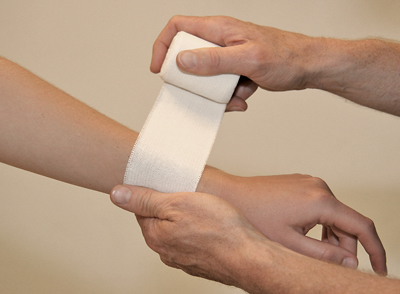When applying a roller bandage, a number of rules apply:
- Avoid vascular congestion. By applying a bandage too tightly or as the result of uneven tension in the bandage during application, greater pressure will be exerted on the blood circulation at one point than elsewhere. This pressure can cause vascular congestion in the superficial blood circulation. The cyanotic swelling which may develop as a result usually develops distal to the bandage. Venous return will be more likely to be affected than the deeper blood supply. Uneven pressure on the tissue can also cause swelling under the layer of bandaging or in an uncovered area between the bandage turns. To avoid congestion, the following measures should be taken:
- Push the blood in the superficial veins towards the heart by applying the roller bandage to the limb in a distal to proximal direction.
- Keep overlapping or covering the previous turn.
- There should be no skin visible between two successive turns.
- Space the turns equally.
- This ensures that the layers of bandage are distributed evenly across the body part.
- When unrolling the bandage, maintain a constant tension.
- This will ensure that each turn exerts the same pressure on the underlying tissue.
- Differences in tension are most likely to occur when switching the bandage roll from one hand to another.
- Support the limb.
- Have the patient rest their arm or leg on a table or chair.
- If necessary, ask someone else to hold the limb.
- If the patient holds their arm up unassisted, the muscles in the arm will be tensed.
- This muscle activity will cause the circumference of the limb to increase.
- Once the muscles relax, the bandage will be too loose and no longer fulfil its purpose.
- Place the joint in the physiological position.
- A physiological position is one where the tension in the flexing and extending muscles is in equilibrium.
- This equilibrium can be identified by moving a leg (from a flexed position to one where it is extended).
The point where no tension can be felt in either the flexing or tensing muscles is the physiological position. If a joint is bandaged in an incorrect position, constant overstretching of the flexor and extensor muscles can result in tiredness and irritation. Under unfavourable circumstances, prolonged fixation in a non-physiological position can result in contractures. The physiological position is expressed in degrees, by measuring the angle at the flexed side of the joint.
- Choose the width of the bandage roll carefully. It is difficult to draw up an overview of the ideal bandage widths for each different body part and for each age. Advice for selecting the bandage is provided under the bandaging technique descriptions. When applying compression, support or immobilising bandages, it is important to choose a roller bandage with a wide width. If a narrow bandage roll is used, particularly if elasticated, the pressure will be distributed over an area which is too small.
- When unrolling the bandage, place the outer side of the bandage roll on the skin [Figure 18]. This position is also called ‘looking into the roll.’ The picture shows how the roll should be held in the hand. This way, the number of finger movements involved in unrolling the bandage is limited, and the risk of the bandage rolling out of the hand is minimised.
 Figure 18
Figure 18
- Choose a fixed direction in which to make the turns. Make a habit of always unrolling the bandage in the same direction, unless the turns have to go in a specific direction. It is often taught that bandaging should be applied in a lateral to medial direction, but there are no strong arguments to support this. It is more important to follow your own natural movement. For those who are right-handed, this will usually be from left to right, and for those who are left-handed, it will be from right to left. If a specific direction is essential, this will be clearly indicated in the description of the bandaging technique.




























